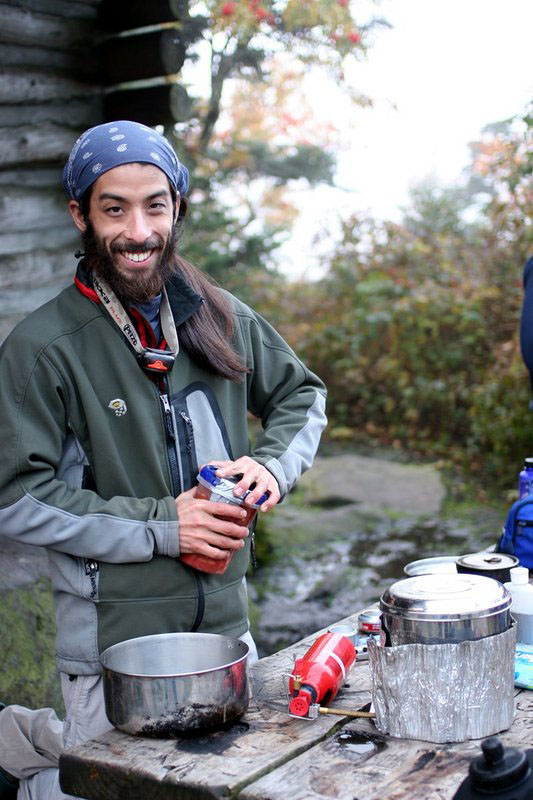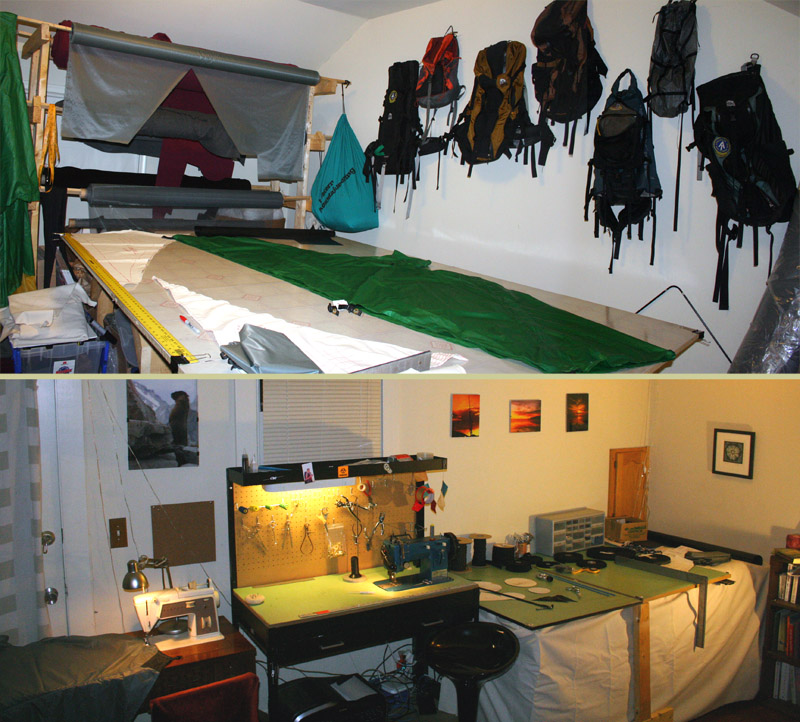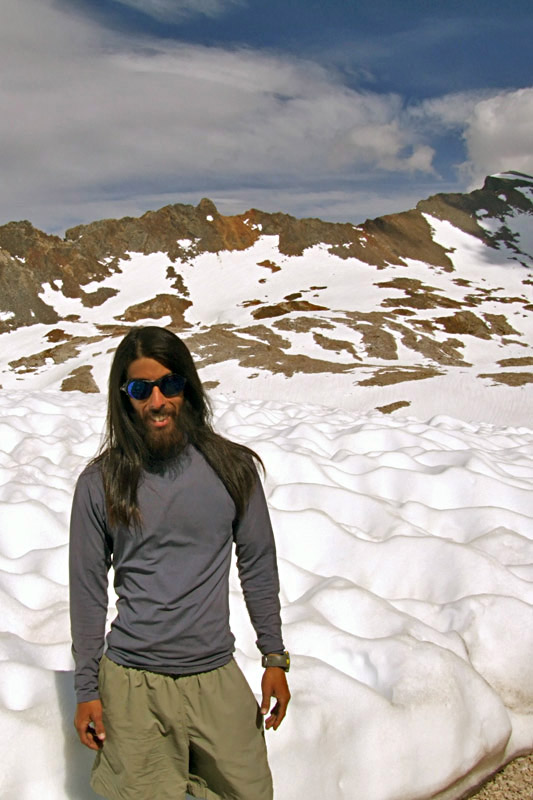The year is 2010 and my series of cottage manufacturers continues. For the first interview of the year I sought out a cottage manufacturer who is relatively unknown, wrongly as I believe, because Gen Shimizu, the man behind Alpinlite Gear offers some very innovative products with fair prices. But not only his products are innovative, also his approach to do business and his willingness to give something back to the UL community. Grab a cuppa and read on to see what I mean!

Gen Shimizu of Alpinlite Gear.
Gen, please briefly introduce yourself and tell us who you are. Since when are you backpacking, and how did you start? How often are you out backpacking nowadays?
I hiked almost every weekend while growing up and enjoyed overnight backpacking trips on the Appalachian Trail. I also spent a lot of time mountain biking, sailing, canoeing and cross country skiing. In 2003 I earned my B.S. in Mechanical Engineering from the University of Virginia in Charlottesville, where I live today. Since, I've worked as a fabricator of carbon fiber products and continue to work as a CAD Operator at a campus design firm.
My obsession with backpacking began in 2004 when I thru-hiked the Appalachian Trail (AT). In 2006 I hiked about 1200 miles (2000km) of the Pacific Crest Trail (PCT). I try to head out for weekend to week-long trips whenever I have the chance and I really enjoy leading backpacking trips for the Outdoors Club at the University of Virginia. It's very rewarding to hook others onto the activity that has so impacted my life.
Are you a lightweight/ UL backpacker? If so, what is your typical baseweight?
I tend to be more of a lightweight hiker than an ultralight hiker, but I've also been known to carry a bit more than I care to admit. My typical baseweight is probably around 15 - 20 lbs (7 - 9 kg) but has been anywhere between 8 - 45 lbs (3.5 - 20 kg) depending on the situation. I like to be light but I'm not a gram-counter. I carried 5 lbs of camera equipment on the AT!
Alpinlite has some very unique designs like the Stratiform I & III tarps and the Microburst Poncho-Tent. Can you two tell us a little bit about the beginnings of Alpinlite, the birth of your tarp designs, and how it developed over time?
The idea for Alpinlite began during my hike on the PCT in 2006. A good buddy of mine, Chewy, and I passed much time discussing how we would set up our 'ideal' gear company. To consolidate several days of discussion into one sentence: We planned to encourage a free exchange of information between the consumer and manufacturer so that the consumer would become an integral part of the design process. One of my goals is to put all of my products up into the 'Do It Yourself' section of the website so that others can make their own gear and help 'evolve' the designs. I'd like to provide a public area of discussion for each product to discuss what is successful and what isn't, and ways in which the product might be improved.
The Microburst Poncho-Tent had its beginnings on the PCT and was the first product I prototyped. I had tried out a 5' x 8' poncho-tarp during my hike and started dreaming up ways to make an enclosed shelter from a poncho. The idea for the 'triangular' pole orientation was proposed by Chewy as a way to increase the stability of tarp tents. It took two years for my poncho-tarp to evolve into the Microburst available today and is Alpinlite's 'flagship' product.
The Stratiform Tarps were designed in response to a need to provide a tarp to pitch over my Bug Shelters as well as to provide a catenary tarp in Alpinlite's lineup.

The Alpinlite Gear workshop.
Gen, we love to be let in on the work-in-progress stuff! Can you let us know a tiny bit on what kind of new products we might be able to get in the future from Alpinlite, besides the Cirriform Cuben Tarp?
Gear for groups and gear for couples. I love to lead groups trips and would like to explore lightweight gear designed for group use. I also feel there is a gap in the current industry, both lightweight and traditional, for couples. I'd like to develop gear designed to be used by two, especially items that can be split between the individuals for solo use in emergencies (ie. a 2-piece tarp that could also function as two individual tarps).
I'm also very interested in bicycle touring and may experiment with gear in that area someday.
How works the R&D at Alpinlite, do you have a need yourself that you try to fix, or do some of your clients inspire you for new products or ask you for solutions to their problems?
Many of my products begin with the customer. Often someone will inquire about a custom piece of gear. The Stratiform III for example, began as a custom tarp to partner with a custom bug shelter I was making for Jim Meyer's hike of the Bibbulmun Track. I'll take on a custom project like this when I think it will fill a gap in Alpinlite's lineup. With the Stratiform III, I had already been working on some catenary tarps but with input from Jim, the project took a unique direction and turned into something better.
What is the most sold piece of gear from Alpinlite? Also, where do your customer come from?
The Bug Shelter 1 and Bod-i-Bags were quite popular last year, however I've discontinued the Bod-i-Bag line to focus more attention to my tarps. With the introduction of the slightly larger Bug Shelter 1.25 and Stratiform tarps to go with, I expect these to be the biggest sellers this season. Most customers are from the Eastern US and Pacific Northwest. I've had several customers hailing from Asian countries and Australia but only a handful from European countries.

What is your own favorite backpack, sleep system and shelter?
I usually use Granite Gear packs, but my favorite pack is the Dana Design Racer X that I used on the AT. It's essentially a 25L dry bag lashed onto a minimal internal frame.
I'm a very cold sleeper so my sleep system often leaves me wanting more. I prototyped a Primaloft Bod-i-Bag last year which has been a welcomed addition to my sleep system.
A simple rectangular tarp is very nice for its versatility, coverage and low weight. For a more substantial shelter, I really liked my Big Agnes Seedhouse 1.
When and where was your last longer backpacking trip, and what was your baseweight? Are you planning to get out for a trip soon, and enjoy the winter season in Virginia?
My last big trip was my PCT hike in 2006. Since then, some highlights have been week long trips to Great Sand Dunes National Park in Colorado, the Red River Gorge in Kentucky, and canoe camping in the Everglades of Florida. My baseweight on the PCT was around 20 lbs. (9 kg) but varied quite a bit. I'm planning a 2011 PCT thru-hike attempt with my girlfriend so I'll have to have some of that 2-person gear I mentioned ready by then!
Winter in Virginia leaves something to be desired. I love to go snowshoeing at Dolly Sods in West Virginia; a little winter oasis receiving 160" (4 meters) of annual snowfall!
Do you think ultralight backpacking will become more popular and break into the mass market, or will it continue to be something for a small group of people?
I think the activity of ultralight backpacking itself will remain a niche but I expect the trend towards lighter weight gear to continue to grow. I think the design methods and materials unique to UL/Lightweight gear will have increased influence in the mainstream market but not replace more traditional gear.
Are you the cooperating "behind the scenes" with other cottage manufacturers? Are you for example in contact with any of the other cottage manufacturers, and talking about developments and the like?
I'm not in touch with other manufacturers but would welcome discussion and sharing of information.
Gen, I thank you for taking the time to answer my questions. Is there something you would like to add?
Thanks for interviewing me. I was honored to be asked and look forward to reading the other interviews and following your blog. Keep up the good work!

Gen Shimizu of Alpinlite Gear.
Gen, please briefly introduce yourself and tell us who you are. Since when are you backpacking, and how did you start? How often are you out backpacking nowadays?
I hiked almost every weekend while growing up and enjoyed overnight backpacking trips on the Appalachian Trail. I also spent a lot of time mountain biking, sailing, canoeing and cross country skiing. In 2003 I earned my B.S. in Mechanical Engineering from the University of Virginia in Charlottesville, where I live today. Since, I've worked as a fabricator of carbon fiber products and continue to work as a CAD Operator at a campus design firm.
My obsession with backpacking began in 2004 when I thru-hiked the Appalachian Trail (AT). In 2006 I hiked about 1200 miles (2000km) of the Pacific Crest Trail (PCT). I try to head out for weekend to week-long trips whenever I have the chance and I really enjoy leading backpacking trips for the Outdoors Club at the University of Virginia. It's very rewarding to hook others onto the activity that has so impacted my life.
Are you a lightweight/ UL backpacker? If so, what is your typical baseweight?
I tend to be more of a lightweight hiker than an ultralight hiker, but I've also been known to carry a bit more than I care to admit. My typical baseweight is probably around 15 - 20 lbs (7 - 9 kg) but has been anywhere between 8 - 45 lbs (3.5 - 20 kg) depending on the situation. I like to be light but I'm not a gram-counter. I carried 5 lbs of camera equipment on the AT!
Alpinlite has some very unique designs like the Stratiform I & III tarps and the Microburst Poncho-Tent. Can you two tell us a little bit about the beginnings of Alpinlite, the birth of your tarp designs, and how it developed over time?
The idea for Alpinlite began during my hike on the PCT in 2006. A good buddy of mine, Chewy, and I passed much time discussing how we would set up our 'ideal' gear company. To consolidate several days of discussion into one sentence: We planned to encourage a free exchange of information between the consumer and manufacturer so that the consumer would become an integral part of the design process. One of my goals is to put all of my products up into the 'Do It Yourself' section of the website so that others can make their own gear and help 'evolve' the designs. I'd like to provide a public area of discussion for each product to discuss what is successful and what isn't, and ways in which the product might be improved.
The Microburst Poncho-Tent had its beginnings on the PCT and was the first product I prototyped. I had tried out a 5' x 8' poncho-tarp during my hike and started dreaming up ways to make an enclosed shelter from a poncho. The idea for the 'triangular' pole orientation was proposed by Chewy as a way to increase the stability of tarp tents. It took two years for my poncho-tarp to evolve into the Microburst available today and is Alpinlite's 'flagship' product.
The Stratiform Tarps were designed in response to a need to provide a tarp to pitch over my Bug Shelters as well as to provide a catenary tarp in Alpinlite's lineup.

The Alpinlite Gear workshop.
Gen, we love to be let in on the work-in-progress stuff! Can you let us know a tiny bit on what kind of new products we might be able to get in the future from Alpinlite, besides the Cirriform Cuben Tarp?
Gear for groups and gear for couples. I love to lead groups trips and would like to explore lightweight gear designed for group use. I also feel there is a gap in the current industry, both lightweight and traditional, for couples. I'd like to develop gear designed to be used by two, especially items that can be split between the individuals for solo use in emergencies (ie. a 2-piece tarp that could also function as two individual tarps).
I'm also very interested in bicycle touring and may experiment with gear in that area someday.
How works the R&D at Alpinlite, do you have a need yourself that you try to fix, or do some of your clients inspire you for new products or ask you for solutions to their problems?
Many of my products begin with the customer. Often someone will inquire about a custom piece of gear. The Stratiform III for example, began as a custom tarp to partner with a custom bug shelter I was making for Jim Meyer's hike of the Bibbulmun Track. I'll take on a custom project like this when I think it will fill a gap in Alpinlite's lineup. With the Stratiform III, I had already been working on some catenary tarps but with input from Jim, the project took a unique direction and turned into something better.
What is the most sold piece of gear from Alpinlite? Also, where do your customer come from?
The Bug Shelter 1 and Bod-i-Bags were quite popular last year, however I've discontinued the Bod-i-Bag line to focus more attention to my tarps. With the introduction of the slightly larger Bug Shelter 1.25 and Stratiform tarps to go with, I expect these to be the biggest sellers this season. Most customers are from the Eastern US and Pacific Northwest. I've had several customers hailing from Asian countries and Australia but only a handful from European countries.

What is your own favorite backpack, sleep system and shelter?
I usually use Granite Gear packs, but my favorite pack is the Dana Design Racer X that I used on the AT. It's essentially a 25L dry bag lashed onto a minimal internal frame.
I'm a very cold sleeper so my sleep system often leaves me wanting more. I prototyped a Primaloft Bod-i-Bag last year which has been a welcomed addition to my sleep system.
A simple rectangular tarp is very nice for its versatility, coverage and low weight. For a more substantial shelter, I really liked my Big Agnes Seedhouse 1.
When and where was your last longer backpacking trip, and what was your baseweight? Are you planning to get out for a trip soon, and enjoy the winter season in Virginia?
My last big trip was my PCT hike in 2006. Since then, some highlights have been week long trips to Great Sand Dunes National Park in Colorado, the Red River Gorge in Kentucky, and canoe camping in the Everglades of Florida. My baseweight on the PCT was around 20 lbs. (9 kg) but varied quite a bit. I'm planning a 2011 PCT thru-hike attempt with my girlfriend so I'll have to have some of that 2-person gear I mentioned ready by then!
Winter in Virginia leaves something to be desired. I love to go snowshoeing at Dolly Sods in West Virginia; a little winter oasis receiving 160" (4 meters) of annual snowfall!
Do you think ultralight backpacking will become more popular and break into the mass market, or will it continue to be something for a small group of people?
I think the activity of ultralight backpacking itself will remain a niche but I expect the trend towards lighter weight gear to continue to grow. I think the design methods and materials unique to UL/Lightweight gear will have increased influence in the mainstream market but not replace more traditional gear.
Are you the cooperating "behind the scenes" with other cottage manufacturers? Are you for example in contact with any of the other cottage manufacturers, and talking about developments and the like?
I'm not in touch with other manufacturers but would welcome discussion and sharing of information.
Gen, I thank you for taking the time to answer my questions. Is there something you would like to add?
Thanks for interviewing me. I was honored to be asked and look forward to reading the other interviews and following your blog. Keep up the good work!